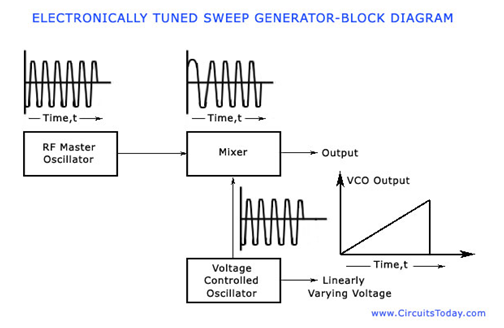Need know about the working of a sweep-frequency generator
A sweep frequency generator is a type of signal generator that is used to generate a sinusoidal output. Such an output will have its frequency automatically varied or swept between two selected frequencies. One complete cycle of the frequency variation is called a sweep. depending on the design of a particular instrument, either linear or logarithmic variations can be introduced to the frequency rate. However, over the entire frequency range of the sweep, the amplitude of the signal output is designed to remain constant.
Sweep-frequency generators are primarily used for measuring the responses of amplifiers, filters, and electrical components over various frequency bands. The frequency range of a sweep-frequency generator usually extends over three bands, 0.001 Hz – 100 kHz (low frequency to audio), 100 kHz – 1,500 MHz (RF range), and 1-200 GHz (microwave range). It is really a hectic task to know the performance of measurement of bandwidth over a wide frequency range with a manually tuned oscillator. By using a sweep-frequency generator, a sinusoidal signal that is automatically swept between two chosen frequencies can be applied to the circuit under test and its response against frequency can be displayed on an oscilloscope or X-Y recorder.
Thus the measurement time and effort is considerably reduced. Sweep generators may also be employed for checking and repairing of amplifiers used in TV and radar receivers.
The block diagram of an electronically tuned sweep frequency generator is shown in the figure below.

The most important component of a sweep-frequency generator is the master oscillator. It is mostly an RF type and has many 0perating ranges which are selected by a range switch. Either mechanical or electronic variations can be brought to the frequency of the output signal of the signal generator.
In the case of mechanically varied models, a motor driven capacitor is used to tune the of the output signal of the master oscillator.
In the case of electronically tuned models, two frequencies are used. One will be a constant frequency that is produced by the master oscillator. The other will be a varying frequency signal, which is produced by another oscillator, called the voltage controlled oscillator (VCO). The VCO contains an element whose capacitance depends upon the voltage applied across it. This element is used to vary the frequency of the sinusoidal output of the VCO. A special electronic device called a mixer is then used to combine the output of the VCO and the output of the master oscillator. When both the signals are combined, the resulting output will be sinusoidal, and its frequency will depend on the difference of frequencies of the output signals of the master oscillator and VCO. For example, if the master oscillator frequency is fixed at 10.00 MHz and the variable frequency is varied between 10.01 MHz to 35 MHz, the mixer will give sinusoidal output whose frequency is swept from 10 KHz to 25 MHz.
Adjustments can be brought to the sweep rates in a sweep frequency generator and it normally can be varied from 100 to 0.01 seconds per sweep. The X-axis of an oscilloscope or X-Y recorder can be easily driven synchronously with a voltage that varies linearly or logarithmically. In the electronically tuned sweep generators, the same voltage which drives the VCO serves as this voltage.
When the frequency varies linearly or logarithmically, the values of the end frequencies can be used to find the frequency of various points along the frequency-response curve. Markers can be employed for more accuracy.
This article is from Allicdata Electronics Limited. Reprinted need to indicate the source

